必修四Unit 3语法 非谓语动词ing(II)
高中英语人教必修四:Unit3SectionⅢGrammar—动词ing形式作表语、定语和宾语补足语
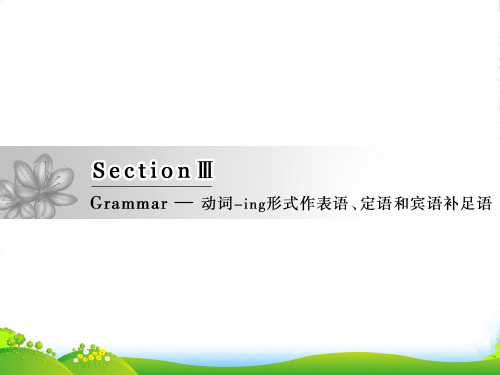
即时演练 3 3-1.用所给动词的适当形式填空 ①(全国卷Ⅱ改编)They use computers to keep the
traffic running (run) smoothly.
②(辽宁高考改编)The old couple often take a walk after supper in the park with their pet dog
自主探究
(1)动词ing 形式可在句中作 表语 (句⑦)。 (2)动词ing 形式可在句中作 定语 (句②、③、⑤)。 (3)动词ing 形式可在句中作 宾语补足语 (句①、④、
⑥)。 (4)由句②和句③可以看出单个现在分词作定语时要放在
它所修饰的名词之 前 ;现在分词短语作定语时放在它所 修饰的名词之后 。
即时演练 2 2-1.用所给动词的适当形式填空
①Our school went on an organized (organize)
trip last week.
②He said if we had any questions to ask (ask),
he would help us. ③(山东高考改编)There's a note pinned to the door
following (follow) them.
3-2.完成句子
③I suddenly felt myself being hit by a heavy
fist. 我突然感到自己被重重地打了一拳。
④His question has set me thinking .
他的问题让我深思。
⑤We shouldn't keep our lights burning in the
高中英语人教版必修4非谓语动词doing专题讲解与巩固练习
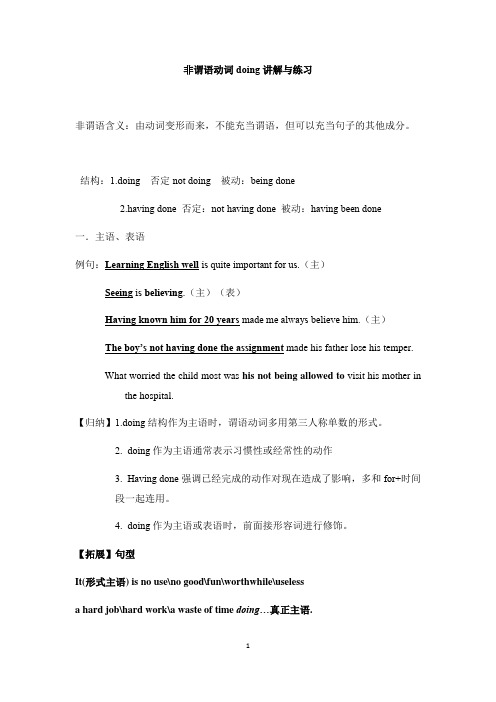
非谓语动词doing讲解与练习非谓语含义:由动词变形而来,不能充当谓语,但可以充当句子的其他成分。
结构:1.doing 否定not doing 被动:being done2.having done 否定:not having done 被动:having been done一.主语、表语例句:Learning English well is quite important for us.(主)Seeing is believing.(主)(表)Having known him for 20 years made me always believe him.(主)The boy’s not having done the assignment made his father lose his temper.What worried the child most was his not being allowed to visit his mother in the hospital.【归纳】1.doing结构作为主语时,谓语动词多用第三人称单数的形式。
2.doing作为主语通常表示习惯性或经常性的动作3.Having done强调已经完成的动作对现在造成了影响,多和for+时间段一起连用。
4.doing作为主语或表语时,前面接形容词进行修饰。
【拓展】句型It(形式主语) is no use\no good\fun\worthwhile\uselessa hard job\hard work\a waste of time doing…真正主语.【巩固练习】1.It's no use _______(spend)_so much money on clothes.2. I don't think it's much good __________(tell) to him.3.Your __________(fail)the exam will disappoint your parents.4.___________(expose) to sunlight for too much time will do harm to one's skin.5.The president’s __________(attend) the meeting himself gave them a great deal of encouragement.二.宾语位置:放在及物动词或介词之后(1)常见动词口诀2)need, require, want, deserve(应得)+doing=to be done.(以物作为主语)3)在excuse, forgive, pardon+形容词性物主代词+doing或者+宾格+for doing。
必修4 Unit3 Grammar 现在分词作定语和宾补

A 5.They knew her well. They had seen her ___ up from childhood. A. grow B. grew C. was growing D. to grow B 6. We will make it ___to all ___ she is a new teacher. A.knowing, that C. known, who B. known, that D. knowing,
应用现在分词作宾语补足语,要掌握好三个“区别” 注:应用现在分词作宾语补足语,要掌握好三个“区别”
1 现在分词主动式作宾补和不定式主动式作宾补 现在分词主动式作宾补表示一个正在进行的主动动 作,不定式主动式作宾补表示动作的全过程或即将发生 的动作。试比较: 1)I heard him playing the piano in the next room. 2)Now let me hear you play the piano a second time.
• • • •
请你判断下列-ing形式 请你判断下列-ing形式 在句中所充当的成分 1. In many countries, shaking one’s head means “no” while nodding means “yes”. 主语 2. We can learn a lot about what a person is 介宾 thinking by watching his or her body language. 3. A good way of saying “I am full” is rubbing the 表语 stomach after a meal. 4. An old man walked into the waiting room with a walking stick in his hand. 定语
人教版高中英语【必修四】[动词ing形式作表语-定语和宾语补足语

人教版高中英语必修四知识点梳理重点题型(常考知识点)巩固练习动词ing形式作表语,定语和宾语补足语概念引入:The music they are playing sounds so exciting .We watched three boys sharing their food with eachOur job is playing all kinds of music .`The girl singing now is a classmate of mine语法讲解【356774 ,非谓语动词之-ing形式,非谓语动词之ing形式】非谓语动词中的ing形式包括两种:一种是动名词,另外一种是现在分词。
•基本形式:》1、-ing形式作表语1) -ing形式作表语时放在系动词之后,用来泛指某种动作或行为,以说明主语的具体内容(身份、性质或情况)。
如:Her hobby is painting.她的业余爱好是画画。
My job is looking after the children.我的工作就是照顾这些孩子。
2) –ing用来表示主语所具有的特征,如:His concern for his mother is most touching."他对母亲的关爱很感人。
His words are encouraging.他的话很鼓舞人。
2、-ing形式作定语1). 说明被修饰名词的作用和用途,如:building materials= materials for building 建筑材料drinking water*= water for drinking 饮用水a reading room= a room for reading 阅览室2). 说明被修饰名词的作用和用途,如:tiring music= music that is tiring 烦人的音乐a surprising result= a result that is surprising,一个惊人的结果3). 表示被修饰名词正在进行的动作,如:正在做实验的那个学生是我们的班长。
必修四unit3grammarv-ing做宾补、定语和表语

动词-ing做主语和宾语
动名词 做主语
1动词-ing形式作主语的句型
•位于句首 •it作形式主语,而将其v-ing移后
2 there be 句式中的v-ing形式
3 v-ing形式和to do 不定式作主语的区 别
1.作主语时通常有两种位置:一种是位于句首; 另一种是it 作形式主语,而将v.-ing 移至后面。
3. 动词forget, go on, mean, regret, remember, stop, try, be used to, can't help后跟动名词和跟不定式区别较大,须
注意。
forget, regret, remember后跟动名词,
动名词表示已经发生的动作;后跟不定式
表示将要发生的动作。
2.使役动词set, keep, have 等
1. 动词-ing形式作宾语补足语常放在宾 语后面,表示一个正在进行的主动性的 动作,强调一个过程或一种状态。
当我们回到学校时, 发现一个陌生人站 在大门口。 When we returned to the school, we found a stranger_s_ta_n_d_i_n_g__a_t _th__e_g_a_te.
• 那老板让工人整夜地工作。
• The boss kept the workers _w_o_r_k_i_n_g_a_l_l_n_i_g_h_t_______.
• 别让让他在外边雨中等待。
• Don't leave him _w_a_i_ti_n_g_o_u__ts_i_d_e_i_n_t_h_e_r_a_i_n.
【考例】
— Let's have a rest. — Not now.I don't want to stop __________ yet.(MET 1985)
人教高中英语必修4Unit3 Grammar课件

最新
9
作状语时的区别:
-ing form,pp表示时间、原因、条件、方式、伴随情况等等,
to do表示1.目的; 2.结果—表示出人预料的情况或结果。常用only强调。 3.原因—表示造成情感变化的原因。
eg.they worked hard to pay for the necklace. 目的
-ing form表示主动,正在进行,pp表示被动,已经完成
作表语时或定语时,-ing form表示“令人” ,pp表 示“感到”,常见的有下列感官动词: move ,surprise,astonish,delight,comfort,disappoint, puzzle,frighten
作宾补时,比较对象为宾语
5.Having noted down her name,the man went away. 先
最新5ຫໍສະໝຸດ 非谓语动词功能比较to do
主表宾定补状 语语语语语语
-ing form
pp
最新
6
主语、表语、宾语
1. to do 表示具体的动作,-ing form表示泛指的动作。
eg.I like skating,but I don’t like to skate today. Playing with fire is dangerous. Look out!To play with fire is dangerous. 2.“there is no +主语”句型中,多用-ing form.
最新
8
补语
-ing form与宾语为主动关系,强调动作正在进行; pp与宾语为被动关系,强调动作已经完成; to do只单纯表示一个事实,强调动作的全过程。
必修四 Unit 3 Grammar 现在分词作表语,定语,宾语补足语

5.(2012江西) John has really got the job because he showed me the official letter ________ him it. A. offered C.to offer B.offering D.to be offered
6.(2012辽宁)The old couple often take a walk after supper in the park with their pet dog them.
The man standing there is Peter’s father. = The man who is standing there is Peter’s father.
b. 表示经常性的动作或某种状态 (变为从句时 用一般时态)
They lived in a room facing the south.
We saw him cross the road..
我们看见他正在过马路.
We saw him crossing the road..
从A、B、C、D四个选项中,选出可以 填入空白处的最佳选项。 1. The next thing he saw was smoke _____ from behind the house. (2011新 课标全国卷) A. rose B. rising C. to rise D. risen
Look at the examples below, paying attention to the underlined parts. Here the –ing form is used as the object complement, predicative, attribute.
必修四 Unit 4 Section Ⅲ Grammar——动词—ing形式作定语和状语
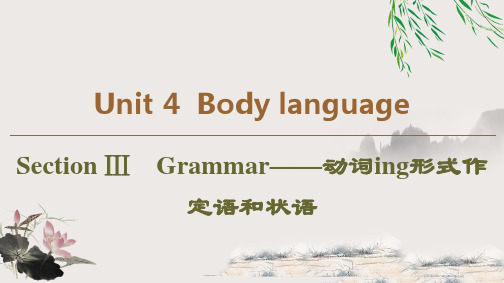
句子中可以作主语、定语、表语、宾语补足语和状语
动词 形式的基本形式如下:
主动语态
被动语态
一般式
doing
being done
完成式
having done
having been done
栏目导航
6
The students walked on the street,talking and laughing.(伴随状 语)
(5)作让步状语。 Having been told many times,he still didn't learn these rules by heart. =Although he had been told many times,he still didn't learn these rules by heart. 尽管被告知了很多次,他还是没把这些规定记住。
,cutting the branches.
=
,and cut the branches.
那个男孩坐在农舍前砍树枝。
栏目导航
17
(7)作方式状语。 He came running back to tell me the news. 他跑回来告诉我这个消息。 [名师点津] 动词 形式作状语时,相当于与之对应的状语从句,但是当 作伴随状语及结果状语时,可转化为并列谓语。
必修4-unit3-ing形式作表语、定语和宾补
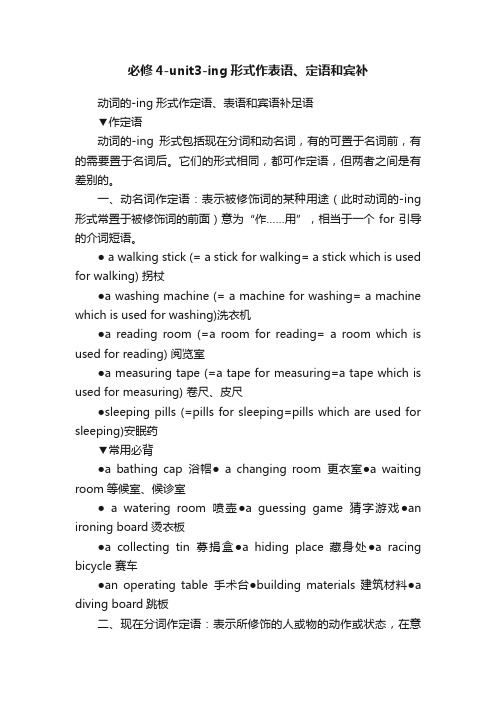
必修4-unit3-ing形式作表语、定语和宾补动词的-ing形式作定语、表语和宾语补足语▼作定语动词的-ing形式包括现在分词和动名词,有的可置于名词前,有的需要置于名词后。
它们的形式相同,都可作定语,但两者之间是有差别的。
一、动名词作定语:表示被修饰词的某种用途(此时动词的-ing 形式常置于被修饰词的前面)意为“作……用”,相当于一个for引导的介词短语。
● a walking stick (= a stick for walking= a stick which is used for walking) 拐杖●a washing machine (= a machine for washing= a machine which is used for washing)洗衣机●a reading room (=a room for reading= a room which is used for reading) 阅览室●a measuring t ape (=a tape for measuring=a tape which is used for measuring) 卷尺、皮尺●sleeping pills (=pills for sleeping=pills which are used for sleeping)安眠药▼常用必背●a bathing cap浴帽● a changing room更衣室●a waiting room等候室、候诊室● a watering room喷壶●a guessing game猜字游戏●an ironing board烫衣板●a collecting tin募捐盒●a hiding place 藏身处●a racing bicycle 赛车●an operating table手术台●building materials 建筑材料●a diving board跳板二、现在分词作定语:表示所修饰的人或物的动作或状态,在意思上接近于一个定语从句,可以表示正在进行的动作,也可表示经常性的动作或当时的状态。
高一英语必修四Unit 3 动词-ing形式

高一英语必修四Unit 3 动词-ing形式Exercises:1. Alien said that his trip was _______.A. interestedB. interestC. interestingD. of interest2. Some people's greatest pleasure is ______ .A. fishingB. to fishC. to be fishD. being fishing3. Remember ______ the book, when you have finished it.A. putting backB. having put backC. to put backD. will put back4. You didn't hear us come back last night. That's good. We tried ______ noisy.A. to not beB. not to beC. being notD. not being5.You'll regret ______ those words. You may hurt her feelings.A. sayB. to sayC. having saidD. to have said6. We are looking forward to ______ another chance ______ it again.A. be given, to tryB. give, to try .C. giving, tryingD. having, to try7. Most of the students enjoy_____ stamps.A. collectB. to collectC. collectingD. collected8. The new shopping center _____ now will be put into use by the end of this year.A. builtB. be builtC. being builtD. to be built9. She was noticed ______ the shop.A. to enterB. enterC. having enteredD. entered10.Anna is often heard ______songs in her room.A. sungB. singingC. singD. to sing11. I'm sorry to have kept you ______ so long a time.A.wait B.to wait C.waited D.waiting12. Don’t leave the water _______ while you brush your teeth.A. runB. runningC. being runD. to run13. John’s bad habit is _____ without thorough understanding.A. readB. being readC. to be readD. reading14. Tell Mary that there’s someone ____ for her at the door.A. waitingB. waitedC. waitsD. to wait15. The _______ waiter came up to us and said, “You are welcome.”A. smilingB. smiledC. smileD. to smile16. Do you know the boy _______ under the big tree?A. layB. lainC. layingD. lying17.The drunken husband knocked against the table and sent the bowls _____ in all directions before he was sent _______ by his wife.A. flying; to sleepB. flying; sleepingC. to fly; to sleepingD. to fly; to sleep18.When we got back from the cinema, we found the lamp ___but the door ___.A. being on; shutB. burning; shuttingC. burning; shutD. on; shutting19. As is known to us all, traveling is _____, but we often feel _____ when we are back from travels.A. interesting; tiredB. interested; tiringC. interesting; tiringD. interested; tired20. The woman found it no good _____ her daughter too much money.A. givingB. being givenC. givenD. gave1. C。
高中英语(人教版)必修四 Unit 4 Body language3单元语法
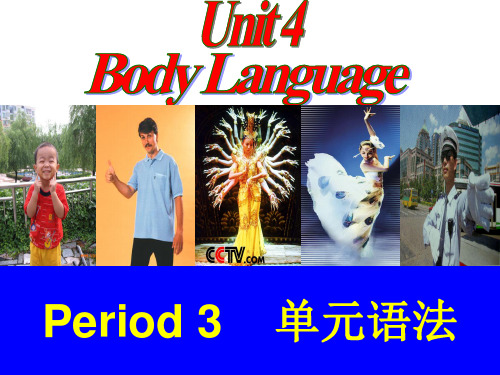
注意: ①当动词的ing形式作状语时,其逻辑主语就是句子的 主语。如果动词的ing形式的逻辑主语和句子主语不一 致,即为错句。 Standing on the top of the mountain,I found the houses below looked like tiny toys. 而不可以说: Standing on the top of the mountain,the houses below looked like tiny toys. 当我站在山顶上时,我发现下面的房子就像小玩具一 样。 When we stood on the top of the mountain,the houses below looked like tiny toys.
【考点警示】 1.v.ing作状语其逻辑主语是该句的主语,注意v.ing 与谓语动词的先后关系,选择v.ing的一般式或完成式。 2.注意v.ing与主语之间有逻辑上的被动关系时,选用 被动体。
【过关强练】 Ⅰ.用v.ing形式改写下列句子 1.The man who is speaking to the teacher is his father. speaking to The man ________ ____ the teacher is his father. 2.In the years that followed,he worked even harder. following In the ________ years,he worked even harder. 3.While he was waiting for the bus,he read a copy of China Daily. While _____ _____ ___ ___ __ waiting for the bus, he read a copy of China Daily. 4.Her mother died in 1990,and left her with her younger brother. leaving her Her mother died in 1990 _____ ___ _ with her younger brother. 5.If you use your head,you will find a way. Using your head _______ _____ _____,you will find a way.
新人教版高一英语必修四Unit 3 语法讲解+练习 ppt课件

2020/12/2
12
二. 动名词作宾语有两种情况。一是有些动
词只能后接动名词作宾语;二是有些动
词既可后接动名词也可后接不定式作宾
语。
① 只能后接动名词作宾语的动词, 常见的
有avoid, consider, enjoy, keep, finish,
2020/12/2
17
1) I remember posting the letter. 我记得我已把信寄了。
2) I’ll remember to post the letter. 我会记着去寄信的。
one special friend? 3) 我们必须设法避免犯同样的错误。
We must try to a_v_o_i_d__re_p_e_a_t_i_n_g the
same mistake.
2020/12/2
14
4) 晚饭后你想和我一起散步吗?
Do youf_e_e_l _li_k_e_h_a_v_i_n_g__a_w_a_l_k_ with
②用形式主语it,把真正的主语——动 名词结构移置句尾。但这种句子形式 有一定的限制,作表语的只能是某些 形容词或少数名词,如useful, useless,good,fun;no use,worth 等。如:
2020/12/2
9
2) 和夏洛克争辩是没有什么用的。 ____I_t_is__u_s_el_e_s_s_a_r_g_u_i_n_g___ with Shylock.
6. He admitted taking the money. 他承认钱是他拿的。
7. I couldn’t help laughing. 我禁不住笑了起来。
(人教版)高中英语必修4:Unit 3 动词ing形式作表语,定语和宾语补足语的概念及语法讲解

动词-ing形式作表语,定语和宾语补足语概念引入:在上一个单元我们已经学过了动词-ing形式作主语和宾语等用法,本单元我们继续学习动词-ing形式作表语、定语和宾语补足语的用法。
看下面句子:1.The music they are playing sounds so exciting.2.We watched three boys sharing their food with each other.3.Our job is playing all kinds of music.4.The girl singing now is a classmate of mine.例句1、3都是-ing形式作表语,例句2是-ing形式作watched的宾语的补足语,而例句4是句子的主语the girl的定语。
那么用动词-ing形式作表语、定语和宾语补足语需要注意什么呢?这就是本单元我们要解决的问题。
语法讲解【非谓语动词之-ing形式非谓语动词之-ing形式】两种动词-ing形式:动词-ing形式是非谓语动词的一种,在传统语法中,动词-ing形式有两个名字,一是动名词,相当于名词,常作主语、宾语、同位语、定语等;另一个是现在分词,相当于形容词或副词,常作表语、宾语补足语、状语、定语等。
动名词的基本形式:现在分词的基本形式:He suggested taking my daughter to the zoo the next Sunday. (动名词的一般式)他建议下个星期天带我女儿去动物园。
Having lived in this city for three years, she knows it very well. (现在分词的完成式)在这个城市生活了3年,她对这里已很熟悉。
I really regretted having missed such an exciting lecture. (动名词的完成式)错过了这么振奋人心的演讲,我真的很遗憾。
语法复习――非谓语动词(一)动词-ing的用法讲解

语法复习——非谓语动词(一)动词-ing的用法非谓语动词主要包括动词-ing形式、过去分词和不定式。
为了区分这三种不同的非谓语动词的用法和含义,我们将分别从三种非谓语动词在句子中所作的成分以及一些特殊句型等角度来区分其用法和细微含义。
本讲主要阐述动词-ing形式的用法。
动词-ing形式起到名词、形容词和副词的作用,在句中可作主语、宾语和表语、状语和宾语补足语,但不能单独构成谓语。
“动词原形+ing”构成动词-ing形式可分为动名词和现在分词。
一、动名词动名词是v.–ing形式的一种,它具有名词特征,可在句子中作主语、宾语、表语。
1.动名词作主语的几种句型动名词直接置于句首作主语,动名词作主语可以是主动形式,也可以是被动形式。
例如: Swimming in winter is healthy. 冬泳是有益健康的运动。
Picking apples is much better than having classes. 摘苹果比上课好多了。
Being elected chairman is a great honor to him. 被选为主席对他是一个很大的荣誉。
有时主语太长,可用it作形式主语,将真正主语即动名词放在后面。
不是所有的动名词作主语都可用it作形式主语,常见的有: It is + no use+动名词做……没有用处 It is + no good +动名词做……没有好处 It is +nice+动名词做……很好/很不错 It is +useless +动名词做……没有用 It is +interesting+动名词做……很有趣 It is +dangerous+动名词做……很危险 It is+a waste of+动名词做……是浪费…… 例如:It is no use waiting here. Let’s walk home. 在这儿等着没有用,我们走回家吧。
It’s interesting watching the children play. 看着这些孩子们玩耍很有趣。
人教版英语必修四Unit 3 A Taste of English Hum专题——非谓语动词教案
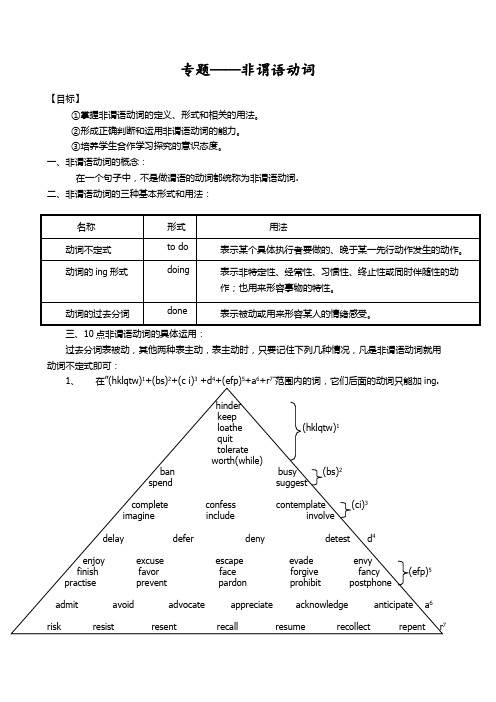
专题——非谓语动词【目标】①掌握非谓语动词的定义、形式和相关的用法。
②形成正确判断和运用非谓语动词的能力。
③培养学生合作学习探究的意识态度。
一、非谓语动词的概念:在一个句子中,不是做谓语的动词都统称为非谓语动词.二、非谓语动词的三种基本形式和用法:过去分词表被动,其他两种表主动,表主动时,只要记住下列几种情况,凡是非谓语动词就用动词不定式即可:1234567”2、接不定式或ing形式区别不大的动词有:好恶性动词:love (dis)like hate prefer dread grudge始续性动词:begin start continue cease忽视性动词:neglect scorn disdain omit耐受性动词:endure stand bear bother动机性动词:intend attempt propose注:当好恶性动词与情态动词would、should连用时,它们后面的非谓语动词只能用带to的动词不定式.3、接不定式或动词ing形式区别大的动词(六个单词三个短语):remember forget stop try mean regret go on can`t help (be) used to注解:4、allow、advise、 permit、 recommend 、 forbid、 report 、 consider、understand、 discuss这九个词要遵循“直接ing,间接或被动时用不定式”的原则,即它们后面直接接动词时要用ing形式,间接接动词或在被动语态当中要用动词不定式。
5、感官动词和使役动词感官动词:see 、watch 、notice 、hear等后面的动词用ing形式表示当时当刻正在进行,用动词原形表示不是正在进行。
使役动词:have 、let 、make后面的非谓语动词用原形表示主动,用过去分词表示被动。
【提示】①感官动词和使役动词被用于被动语态时,后面的非谓语动词要用带to的动词不定式。
- 1、下载文档前请自行甄别文档内容的完整性,平台不提供额外的编辑、内容补充、找答案等附加服务。
- 2、"仅部分预览"的文档,不可在线预览部分如存在完整性等问题,可反馈申请退款(可完整预览的文档不适用该条件!)。
- 3、如文档侵犯您的权益,请联系客服反馈,我们会尽快为您处理(人工客服工作时间:9:00-18:30)。
翔宇监利中学高一英语导学案全年级编写:马莲英审核:王洁201705Unit 3 Book 4 导学案(三) 非谓语动词(二)动词ing作表语、定语和宾补一、划出句子的谓语动词,并说明动词ing在句中充当的成分。
1. His movie is entertaining.2. The prince woke up the sleeping beauty.3. We found ourselves cycling through clouds.4. Make a sentence using the phrase.5. It is no use crying over spilt milk.6. The school forbids smoking.总结:动词ing能在句子中作__________、__________、__________、__________、__________和__________。
二、情绪动词ing和过去分词充当表语、定语和宾补动词ing:令人……的,一般描述事物; 过去分词:感到……的,说明人的感受。
surprise 使人惊讶;amaze_______________; astonish_________________; shock____________; please____________; amuse_______________; entertain_______________; interest__________; puzzle_____________; confuse_____________; bore_____________; disturb________________; frighten _____________; terrify_______________; tire______________; exhaust_____________; encourage鼓励; inspire______________; move____________; touch____________; satisfy___________; charm____________; disappoint______________; discourage___________; frustrate_________________; annoy_______________1. The movie was ______________(frighten). The audience were _____________(frighten) at the movie.2. The audience watched the film with ____________(amuse) expressions. His humor made the film ____________(amuse).三、动词ing作定语的三个用法一)说明名词的功能或作用一个游泳池____________________ 健康的饮食习惯_______________________二)说明动作正在进行注意:动词过去分词说明动作已经完成正在飘落的树叶_____________________ 一个发展中的国家_______________落下的树叶_____________________ 一个发达的国家____________________ 三)说明动作与名词之间是主动关系注意:动词过去分词说明动作与名词之间是被动关系一本解释如何保持健康的书a book ______________(explain) how to keep fit一个被解释清楚的问题a problem ______________(explain) clearly照顾病人的护士nurses ______________(look) after patients被护士照顾的病人patients ____________(look) after by the nurses四、动词ing作宾补的常考结构:与宾语(名词或代词)之间是主动关系注意:动词过去分词与宾语(名词或代词)之间是被动关系1. with+n.+doing 随着/有……做某事with+n.+done 随着/有某事被做With the guide leading the way, we found the destination. 有向导带路,我们找到了目的地。
With the homework finished, I went to watch TV.______________________________________ 2. see/find/hear+n.+doing 看到、发现、听到…正在做某事see/find/hear+n.+done 看到、发现、听到某事被做Then I heard him singing happily. _________________________________________________I found myself surrounded by flowers. ______________________________________________3. have+n.+doing 使……一直做某事have+n.+done ①使得某事被做②遭遇不好的事情They had the machine working all day long. ________________________________________ They had the house decorated. ___________________________________________________ 4. keep +n.+doing 使……一直做某事keep+n.+done 使某事一直被做She kept us waiting for too long. ______________________________________________Don’t keep food stored in the fridge for too long. ________________________________5. can’t/won’t have sb doing sth 不能容忍…做某事I won’t have you shouting at your parents. ______________________________________6. catch sb doing sth 抓住某人做某事The teacher caught him cheating in the exam. ___________________________________五、达标检测----单句填空1. I found myself ____________(attract) by the __________(charm) lady.2. __________________(laugh) at is not desired by anyone.3. The problem was ____________(confuse). What he explained to me made me more ______________(confuse).4. We heard her ______________ (play) the violin when we passed by.5. Washing machines _________(make) by China have won worldwide attention.6. In summer, _________(stay) in the sun for a long time does great harm to our skin.7. After walking for such a long time, we were all ______________(exhaust).8. Is everyone satisfied with the decision _________(make)?9. Lack of food led to his __________(die) of hunger.10. Everyone was touched beyond words by her ____________(move) story.11. When I came back, I caught him _____________(play) computer games online.12. It is no use _____________(complain) about life.13. Americans have little difficulty in understanding the English ______________(speak) by the British.14. I appreciate ___________(have) you as my friend.15. The witness noticed him _________(take) away by the police.16. I won’t have you _________(speak) to your father like that.17. He has mastered a good __________(learn) method.18. Doctors try ___________(use) the new medicine on a small number of patients.19. The book ___________(refer) to by the teacher is worth _______________(read).20. Having completed the task, he wore a _____________(satisfy) smile.21. With all the things _________(buy), she left the supermarket and went home.22. At the beginning of the new term, he meant __________(take) studies seriously.23. Hearing his __________(bore) lecture, I felt sleepy.24. Effective measures should be taken to prevent the world from _________________(pollute).25. Peter had his wallet ________(steal) when shopping in the supermarket.26. His ___________(be) late again made the teacher ___________(annoy).27. I’d like a room ___________(face) the sea.28. He has devoted all his life to ___________(do) scientific research into agriculture.29. Have you ever traveled in a _____________(sleep) car?30. Solar panels are used ___________(produce) electricity.。
